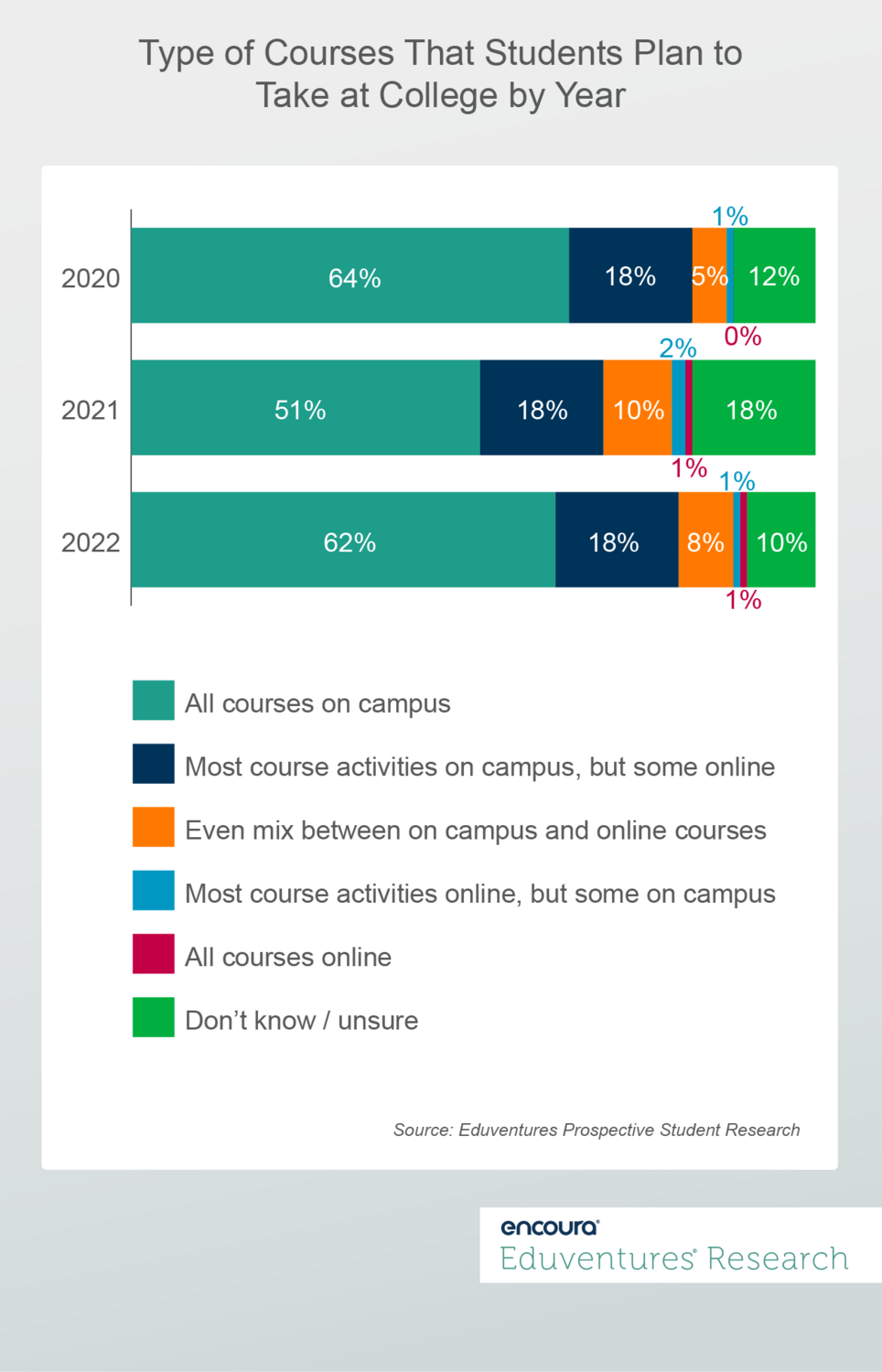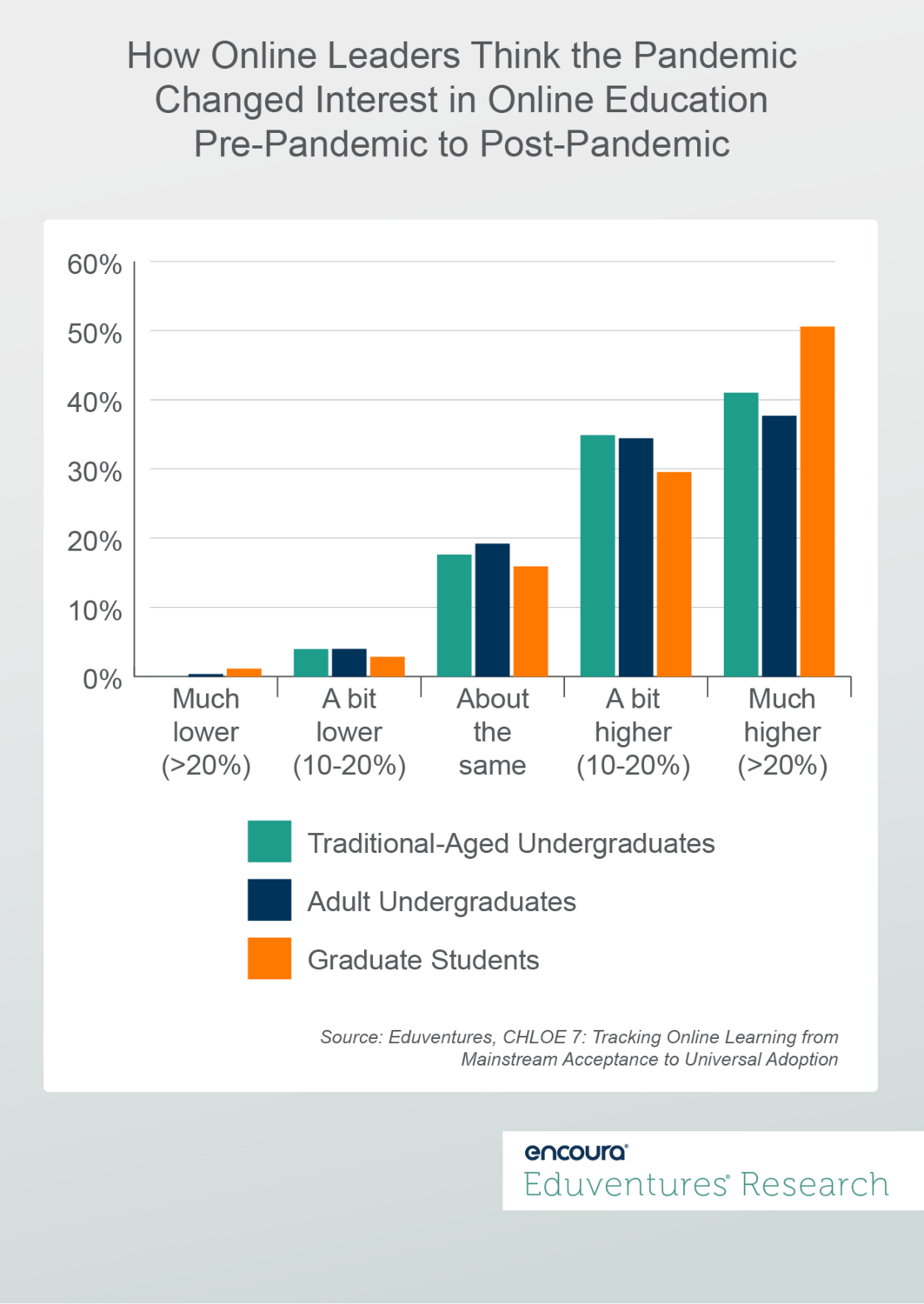We’re at an inflection point with traditional-aged undergraduate education: We can breathe a post-pandemic sigh of relief and go back to an undergraduate education steeped in tradition and circumscribed by the campus and its in-person interactions. Or we can make the leap to reinvigorate undergraduate education by innovating the experience based on our pandemic learnings.
It’s our belief that the latter will help your institution provide relevant education for tomorrow’s so-called “traditional undergraduates.” But truly innovating undergraduate education requires a considered examination of what pandemic-related technology and pedagogy worked and didn’t work. It also requires a demonstration of value to students who currently yearn for tradition.
A Desire for the Traditional
Innovating undergraduate education must take into consideration the current expectation among college-bound high school students of a return to the traditional. Simply put, after the challenges of build-the-airplane-while-you-fly-it remote learning and all its attendant problems, students are expecting a return to the face-to-face education of yesteryear (Figure 1).

Eduventures’ Prospective Student Research™ shows the expectations of traditional-aged students for the modality of courses they will take in college. Prior to the pandemic (2020), almost two-thirds (64%) of students anticipated taking all courses on campus. Nearly a quarter (23%) anticipated some courses online or an even balance. This expectation can be described as largely traditional with some openness to hybrid modality.
During the pandemic (2021), the expectation for fully on-campus courses dropped to about one half (51%) of students. This is no surprise given the pandemic-related closures of colleges. A realism crept in. Students expecting some online or balanced coursework increased to 28%. Another 18% of students were uncertain about delivery. At this point we questioned whether the pandemic would alter openness to hybrid or online experiences in college.
The answer, thus far? High school students are perhaps not so impressed by their remote learning experiences of the past couple of years and foresee a return to the way things were pre-pandemic. Post-pandemic (2022), we see 62% expecting fully on campus courses. The percent of students expecting some online or balanced coursework dropped back slightly to 26%. All of this taken together indicates that high school students don’t necessarily see a future of innovation in the delivery of higher education. But, perhaps there is more to the story.
Delivery Innovations are Coming
Our analysis points to a sliver of an opportunity to show students the possibilities of a more hybrid future. In fact, many institutions may be headed this way with or without the buy-in of students. Chief online officers, in Eduventures' Chloe 7 research, have a rosy view of the changing appetite of traditional students for online education. Figure 2 shows how these leaders think the pandemic has changed interest in online education.

Chief online officers, the evangelists of online education, believe that the vast majority of traditional undergraduate students (76%) have higher interest in online delivery. In fact, most of these leaders believe that students have much higher interest (41%).
This estimate is out of step with what we’ve seen with students’ expectations for a return to a more traditional delivery. Is it realistic to believe that the future of traditional undergraduate education is in innovating the delivery?
Institutions have some right to be bullish. The pandemic has accelerated the capacity to deliver remote instruction; it has also increased faculty education for hybrid delivery. While many aspects of remote instruction were less than ideal for college students during the pandemic, other aspects were real wins for the student experience. Why not, then, do your best to learn from these pandemic experiences to innovate undergraduate education?
Two institutions that have been intentional in examining the COVID experience with an eye on innovating their educational offerings are Harvard University and George Washington University. George Washington University established a Post-Pandemic Academic Innovation Task Force charged with examining “the innovations that emerged during the period of virtual learning necessitated by the pandemic and the implications of these innovations for the future operations of the university.” The task force was comprised of four working groups: faculty, undergraduate, graduate and professional, and staff.
The undergraduate student working group findings showed that students highly valued the residential face-to-face learning experience, had negative-to-mixed reviews of online experiences, wanted to preserve the culture of “empathy," and found some online features useful. Aspects of online delivery that students appreciated were related to accessibility and flexibility (like the ability to meet virtually with professors and to access services like financial aid and advising).
The Bottom Line
It’s certainly possible; they are digital natives after all.
Institutions must first undertake an assessment of the delivery interventions that worked and didn’t work for undergraduates during the pandemic. This will provide a basic framework for developing an ecosystem of hybrid support for undergraduate education.
Students on your campus have their own perspectives on learning support post-COVID, and it’s up to you to understand their perspectives in the context of the other key stakeholders in learning. The engagement of faculty, students, and staff in the creation of a new learning culture is the first critical step to innovating traditional higher education.
This collaborative effort should seek to understand the on-campus and in-person activities and interactions that are most meaningful to student development and successful outcomes. These are the activities to amplify.
Online and hybrid delivery modalities, among other things, should be used to build foundational knowledge, augment in-person interactions, accelerate time to degree, and foster collaboration.
These student desires must be balanced with faculty and staff needs, and institutional capacity to provide the necessary technology infrastructure.
Most of all, institutions must bring students along in this process. If they help design a next-generation undergraduate experience, their trepidation for online will dissipate and they will love what they’ve helped to build.
Never Miss Your Wake-Up Call
Learn more about our team of expert research analysts here.
Eduventures Principal Analyst at Encoura
Contact
This recruitment cycle challenged the creativity of enrollment teams as they were forced to recreate the entire enrollment experience online. The challenge for this spring will be getting proximate to admitted students by replicating new-found practices to increase yield through the summer’s extended enrollment cycle.
By participating in the Eduventures Admitted Student Research, your office will gain actionable insights on:
- Nationwide benchmarks for yield outcomes
- Changes in the decision-making behaviors of incoming freshmen that impact recruiting
- Gaps between how your institution was perceived and your actual institution identity
- Regional and national competitive shifts in the wake of the post-COVID-19 environment
- Competitiveness of your updated financial aid model
July 26, 2022 | 2 PM ET/11 AM PT
Institutional leaders must better understand the changing expectations of current and prospective students.
Join Eduventures® Senior Analyst Johanna Trovato and Salesforce Director of Higher Education Industry Marketing, Navneet Johal for a discussion on student perceptions about institutional marketing and communication as well as students’ inherent college search behaviors. This recent data—from the 2022 Eduventures Student Sentiment Research™ —helps enrollment managers develop their marketing and communication strategies for prospective students, informing on best practices in outreach at every stage of the college search.
Reach Gen Z where they are—on their favorite apps and devices—with Encoura Digital Solutions.
How you engage with prospective students and their families needs to evolve with emerging media trends. As a team of experienced enrollment leaders, we work in tandem with your traditional engagement methods and provide targeted digital media strategies to help you navigate the ever-changing digital landscape.

